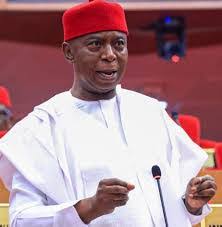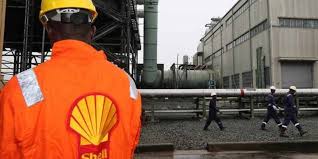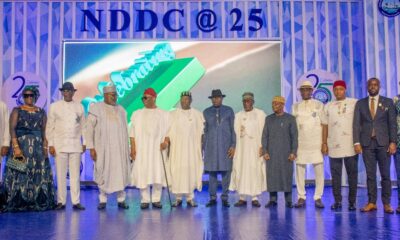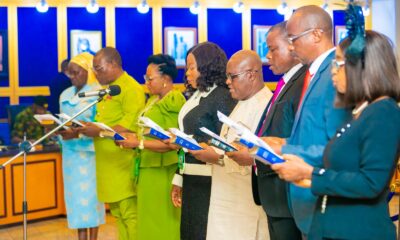Oil & Energy
Periscoping Nigeria’s Economy @ 61
Three days ago, Nigeria celebrated its 61st Independence Anniversary without much fanfare. Apart from the annual ritual of gathering dignitaries at the Eagle Square, Abuja and in every state capital of the country to mark the event, there was no much enthusiasm and euphoria reminiscent of the October 1, 1960 Independence Day.
Like the governor of Rivers State, Chief Nyesom Wike, noted in his Independence Day broadcast, last Friday, there’s not much to be excited about this year’s independence celebration except, perhaps, the fact that “we have remained independent and managed to struggle with our existence for all these years”.
At independence, Nigeria was, no doubt, a great nation with great potential in both human and natural resources. It was a rich and the largest economy in Africa.
Today, given several negative economic indices about the country, can Nigeria truly pride itself as the giant of Africa, again? This is a one million dollar question many Nigerians, including economists and financial experts, may find difficult to answer in the affirmative.
Nigeria may, indeed, take its first position in terms of population, and human/natural endowments in Africa, it is doubtful if it can proudly pride itself as the most progressive economy among its peers, today.
Indices have shown that while many countries that were either at par or trailing behind Nigeria 61 years ago such as Malaysia, Singapore and Ghana, are responding positively to the emerging trend in the global economy, Nigeria appears lethargic, growing at a pace slower than the rate of expansion of its population.
In 1960 for instance, Nigeria’s population was 45.1 million, today, it has grown above 200 million. Yet, only a little above 10 per cent economic progression has been recorded in the last 61 years, to keep up with the population expansion.
It is a sad irony that a country which was once the pride of Africa is, today, one of the poorest countries in the world, with 40 per cent or 83 million of its total population living below the poverty line of less than $1 per day and N137,430 ($381.75) per year, according to the National Bureau of Statistics (NBS) data, last year. And if the World Bank’s income poverty threshold of $3.20 per day is used, Nigeria’s poverty rate is 71 per cent.
It is also a sad commentary that 61 years after attaining independence, Nigeria’s economy which was once strong enough to feed the nation and the rest of Africa is now in tatters, gasping for breath. High inflation, massive unemployment, convulsed social infrastructure and unprecedented debt burden have continued to push more Nigerians into “dehumanising misery and abject poverty”, as Governor Wike rightly noted.
As many businesses are closing shops, many companies are relocating to neighbouring countries like Ghana and South Africa, leading to massive loss of jobs by Nigerians. Twenty seven per cent of Nigeria’s labour force (over 21 million Nigerians) are currently unemployed, according to statistics. Meanwhile, the nation’s currency – the Naira, has practically lost its value as a US dollar which was at par with the Naira in the 1960s is now exchanged for N580.
The grim picture about Nigeria’s economy, inconsistent growth trajectory and poor standard of living have ended up widening the income inequality, increasing the poverty rate and fuelling social tension in the country.
Worst, the Covid-19 pandemic has further worsened Nigeria’s economic growth. As with most other economies around the world, the sharp drop in Nigeria’s Gross Domestic Product (GDP) growth is largely due to the slowdown in economic activity after the country resorted to a lockdown back in April, last year, to curb the spread of the Covid-19 virus.
The accompanying steep drop in oil prices amid a drop in global demand also left Nigeria drastically shorn of earnings given its dependence on the commodity as its biggest revenue source.
For context, the United States slashed its Nigerian crude oil imports oil by 11.67 million barrels in the first five months of 2020, compared to what it bought in the same period of 2019. In fact, in the second quarter of 2020, local oil production dropped to its lowest since 2016, when Nigeria endured a full year of negative growth.
President Muhammadu Buhari himself acknowledged this economic asphyxiation in his Independence Day broadcast when he said “the past eighteen months have been some of the most difficult periods in the history of Nigeria. Since the civil war, I doubt whether we have seen a period of more heightened challenges than what we have witnessed in this period”.
Meanwhile, in spite of several assurances to turn around the fortunes of Nigeria’s economy, the latest economic data shows that the Nigerian government has continued to fall far short of projections in its Economic Recovery and Growth Plan, created in the aftermath of the 2016 recession. From manufacturing, agriculture, solid minerals, oil and gas to service sectors such as aviation and banking, the economy has been like a motion without movement.
Although the economy is not lacking in policy statements and blueprints by successive administrations, positive attitude towards policy implementation appears to be the major albatross militating against its growth.
Save for the telecommunication sector which has emerged as a catalyst for the nation’s economic growth for the past two decades, virtually every other sector is comatose. Power supply is epileptic, aviation industry has continued to wobble with muted ambition, maritime activities are crippled by ports congestion and piracy, trade and investment sector is bitten by the bug of Nigerian factor, the banking industry is feeding fat on a bleeding economy, while the oil and gas sector which has remained the mainstay of the country’s economy for years is shrunk by steep drop in oil prices amid a drop in global demand.
Since 2005 when President Olusegun Obasanjo’s administration liberalised the telecommunication sector, the sector has continued to provide a scaffolding for Nigeria’s broader economic growth. It has emerged as an unbeaten player in the nation’s economy for the past one decade, contributing geometrically to the GDP. Its contribution has almost doubled from 8.5 per cent in 2015 to 14.7 per cent, today.
The NBS latest GDP data shows that the ICT sector grew by 6.47 per cent in Q1 2021, making it the fastest growing sector of the nation’s economy. From a subscriber base of 2, 271, 050 and GDP contributions of 0.85 per cent in 2002, today’s growth has surpassed all projections. Yet, experts say the potential for further growth is huge.
But here appears to be the end of positive stories about Nigeria’s economy. Most other sectors are still finding it difficult to stand on a sound footing. One of such sectors is power. Despite being unbuddled more than a decade ago, the sector has been that of motion without movement over the years. Today, Nigeria’s installed generating capacity is merely 12,500 megawatts (MW) compared to South Africa’s 58, 095 MW, while the electrification rate still lags at 45 per cent, making the sector the missing link in propelling the economy of the country.
It is a sad commentary that a less endowed country like Ghana celebrated one year of uninterrupted power supply more than 10 years ago, whereas Nigeria that prides itself as the giant of Africa has not enjoyed one week of uninterrupted power supply since independence.
Many energy experts have called for a review of the privatisation contract in the face of persistent blackout enveloping the country. For instance, an energy economist at the University of Ibadan, Professor Adeola Adenikinju, lamented that a decade after the defunct Power Holding Company of Nigeria (PHCN) was unbundled and sold to 11 distribution companies (DisCos), Nigeria is still experiencing epileptic power supply amid high tariff.
The aviation sector is not better either. It is one sector that evolves with ambitious developmental policies since independence. One of such policies under the Muhammadu Buhari administration is code-named “Aviation Roadmap”. The policy has components that include a new national carrier, airport concession, aircraft leasing companies, Maintenance Repair and Overhaul (MRO) facility and aerotropolis. Till date, none of these projects has been delivered.
The national carrier, for instance, after its launch in London in 2018, ran into a storm of public criticisms and had to be “temporarily” suspended by the Federal Government. However, there is an indication that the new airline – ‘Nigeria Air’, may hit the sky in 2022.
Similarly, about three years ago, the Federal Executive Council (FEC) approved the concession of four major airports in the country namely Lagos, Abuja, Port Harcourt and Kano. Till date, the facilities are yet to get the requisite patronage from the private sector.
President of the National Union of Air Transport Employees (NUATE), Ben Nnabue, sometimes ago, took a swipe at the aviation sector.
He said that whereas a state government like Akwa Ibom has since successfully launched its airline (Ibom Air) without any fanfare, “our country has woefully failed in its attempt to birth a national carrier after over 10 years of labour and colossal financial waste”.
He continued: “The proposed aircraft leasing company, national aircraft Maintenance, Repair and Overhaul (MRO) facility and aerotropolis development, all flagship programmes of this federal administration, have all suffered paralysis, despite massive support from all stakeholders and informed Nigerians.
“They all followed the same path; bitten by the bug of hidden agenda, suffered the ailment of ill-motive to death, presently in the coffins of infidelity to the national cause, and awaiting to be buried in the grave of onemarism”.
Nnabue also described the airport concession as a travesty, aimed at draining the nation’s treasury and called on the Federal Government to put a halt to it.
Many stakeholders, however, believe that the aviation sector has retained a good measure of stability under the Buhari administration. According to a member of the Aviation Safety Round Table Initiative (ASRTI), Olumide Ohunayo, the sector has sustained safety standards, retained Category-One rating, got good approvals from the Federal Government and received a palliative during the Covid-19 pandemic.
He said the only drawback was the non-implementation of the aviation roadmap components which he believes, can still be achieved before the Buhari administration winds down in 2023.
Another sector capable of revving up the engine of the nation’s economy is trade and investment. Unfortunately, like many other sectors, it is bitten by the bug of the Nigerian factor.
While the sector could be said to have recorded some modest achievements in recent times, many experts believe it has not done well in promoting investment inflows into the nation’s economy.
Chairman and Chief Executive Officer of Pan African Development Corporation, Odilim Enwagbara, said that the sector has not been business-friendly to young entrepreneurs who could have possibly impacted their God-given skills on the economy.
According to him, “The Ministry of Industry, Trade and Investment has failed to pursue a nationalistic economic policy, trade diplomacy that would have protected Nigeria’s trade relations interest”.
He called on the government to “invite all small scale business owners to come together with their technical notch that can promote rapid economic development”.
In the area of agriculture, while it is convenient to say that the sector has been a consistent driver of the non-oil sector contributing 22.35% and 23.78% to the overall GDP in the first and second quarter of 2021, it is instructive to note that the impact of investment in the sector is yet to be felt by Nigerians, as the cost of food items in the market is currently getting out of the reach of the common man in the country. No thanks to the twin evil of insecurity and Covid-19.
As it is usually mouthed by every successive administration at every independence anniversary since 1960, Nigeria cannot truly be said to have been stagnant without recording some economic milestones in the last 61 years.
Under the present administration, for instance, some modest achievements have, indeed, been recorded especially in the area of oil and gas, maritime, transport and aviation, among others. The recent passage and signing of the Petroleum Industry Act, 2021; the launching of the NLNG Train 7, and the Deep Blue projects; the introduction of the Electronic Call-Up System and the launching of the Digital Economy are all efforts in the right direction by the Buhari administration.
But how these lofty initiatives intend to deepen the nation’s economy and make Nigeria go beyond a never-ending potential for becoming a great nation to a truly great one remains to be seen.
By: Boye Salau
Oil & Energy
Nigeria Loses More Crude Oil Than Some OPEC Members – Nwoko

Nigeria’s losses due to crude oil theft has been said to be more significant than those of some other members of the Organisation of Petroleum Exporting Countries(OPEC).
The Chairman, Senate Ad- hoc Committee on Crude Oil Theft, Senator Ned Nwoko, made this known in an interview with newsmen in Abuja.
Nwoko noted with dismay the detrimental impact of the issue, which, he said include economic damage, environmental destruction, and its impact on host communities.
According to him, the theft was not only weakening the Naira, but also depriving the nation of vital revenue needed for infrastructure, healthcare, education and social development.
The Senator representing Delta North Senatorial District described the scale of the theft as staggering, with reports indicating losses of over 200,000 barrels per day.
Nwoko disclosed that the ad hoc committee on Crude Oil Theft, which he chairs, recently had a two-day public hearing on the rampant theft of crude oil through illegal bunkering, pipeline vandalism, and the systemic gaps in the regulation and surveillance of the nation’s petroleum resources.
According to him, the public hearing was a pivotal step in addressing one of the most pressing challenges facing the nation.
‘’Nigeria loses billions of dollars annually to crude oil theft. This is severely undermining our economy, weakening the Naira and depriving the nation of vital revenue needed for infrastructure, healthcare, education, and social development.
‘’The scale of this theft is staggering, with reports indicating losses of over 200,000 barrels per day more than some OPEC member nations produce.
‘’This criminal enterprise fuels corruption, funds illegal activities and devastates our environment through spills and pollution.
‘’The public hearing was not just another talk shop; it was a decisive platform to uncover the root causes of crude oil theft, bunkering and pipeline vandalism.
‘’It was a platform to evaluate the effectiveness of existing surveillance, monitoring, and enforcement mechanisms; Identify regulatory and legislative gaps that enable these crimes to thrive.
‘’It was also to engage stakeholders, security agencies, host communities, oil companies, regulators, and experts to proffer actionable solutions; and strengthen legal frameworks to ensure stricter penalties and more efficient prosecution of offenders”, he said.
Nwoko noted that Nigeria’s survival depended
Oil & Energy
Tap Into Offshore Oil, Gas Opportunities, SNEPCO Urges Companies

Shell Nigeria Exploration and Production Company Ltd. (SNEPCo) has called on Nigerian companies to position themselves strategically to take full advantage of the growing opportunities in upcoming offshore and shallow water oil and gas projects.
The Managing Director, SNEPCO, Ronald Adams, made the call at the 5th Nigerian Oil and Gas Opportunity Fair (NOGOF) Conference, held in Yenagoa, Bayelsa State, last Thursday.
Adams highlighted the major projects, including Bonga Southwest Aparo, Bonga North, and the Bonga Main Life Extension, as key areas where Nigerian businesses can grow their capacity and increase their involvement.
“Shell Nigeria Exploration and Production Company Ltd. (SNEPCo) says Nigerian companies have a lot to benefit if they are prepared to take advantage of more opportunities in its offshore and shallow water oil and gas projects.
“Projects such as Bonga Southwest Aparo, Bonga North and Bonga Main Life Extension could grow Nigerian businesses and improve their expertise if they applied themselves seriously to executing higher value contracts”, Adams stated.
Adams noted that SNEPCo pioneered Nigeria’s deepwater oil exploration with the Bonga development and has since played a key role in growing local industry capacity.
He emphasized that Nigerian businesses could expand in key areas like logistics, drilling, and the construction of vital equipment such as subsea systems, mooring units, and gas processing facilities.
The SNEPCO boss explained that since production began at the Bonga field in 2005, SNEPCo has worked closely with Nigerian contractors to build systems and develop a skilled workforce capable of delivering projects safely, on time, and within budget both in Nigeria and across West Africa.
According to him, this long-term support has enabled local firms to take on key roles in managing the Bonga Floating, Production, Storage and Offloading (FPSO) vessel, which reached a major milestone by producing its one-billion barrel of oil on February 3, 2023.
Oil & Energy
Administrator Assures Community Of Improved Power Supply

The Emohua Local Government Area Administrator, Franklin Ajinwo, has pledged to improve electricity distribution in Oduoha Ogbakiri and its environs.
Ajinwo made the pledge recently while playing host in a courtesy visit to the Oduoha Ogbakiri Wezina Council of Chiefs, in his office in Rumuakunde.
He stated that arrangements are underway to enhance available power, reduce frequent outages, and promote steady electricity supply.
The move, he said, was aimed at boosting small and medium-scale businesses in the area.
“The essence of power is not just to have light at night. It’s for those who can use it to enhance their businesses”, he said.
The Administrator, who commended the peaceful nature of Ogbakiri people, urged the Chiefs to continue in promoting peace and stability, saying “meaningful development can only thrive in a peaceful environment”.
He also charged the Chiefs to protect existing infrastructure while promising to address the challenges faced by the community.
Earlier, the Oduoha Ogbakiri Wezina Council of Chiefs, led by HRH Eze Goodluck Mekwa Eleni Ekenta XV, expressed gratitude to the Administrator over his appointment and pledged their support to his administration.
The chiefs highlighted challenges facing the community to include incessant power outage, need for new transformers, and the completion of Community Secondary School, Oduoha.
The visit underscored the community’s expectations from the LGA administration.
With Ajinwo’s assurance of enhancing electricity distribution and promoting development, the people of Oduoha Ogbakiri said they look forward to a brighter future.
By: King Onunwor
-
News19 hours ago
NOA Set To Unveil National Values Charter — D-G
-
Politics16 hours ago
2027: Group Vows To Prevail On Diri To Dump PDP For APC
-

 Features19 hours ago
Features19 hours ago25 Years After: NDDC Celebrates Milestones Of Impactful Development
-
Business20 hours ago
NCDMB Promises Oil Industry Synergy With Safety Boots Firm
-

 News17 hours ago
News17 hours agoRivers Police Arrest Notorious Cultist, Recover Sophisticated Ammunition
-
Niger Delta19 hours ago
Adopt African System Against Crime, Don Urges Security Agencies
-

 News15 hours ago
News15 hours agoIbas Inaugurates RSIEC, Service Commissions, Healthcare Board In Rivers …Charges Appointees To Embrace Principles Of Service
-
Rivers19 hours ago
Monarch Cautions Youths Against Illicit Drug Consumption

